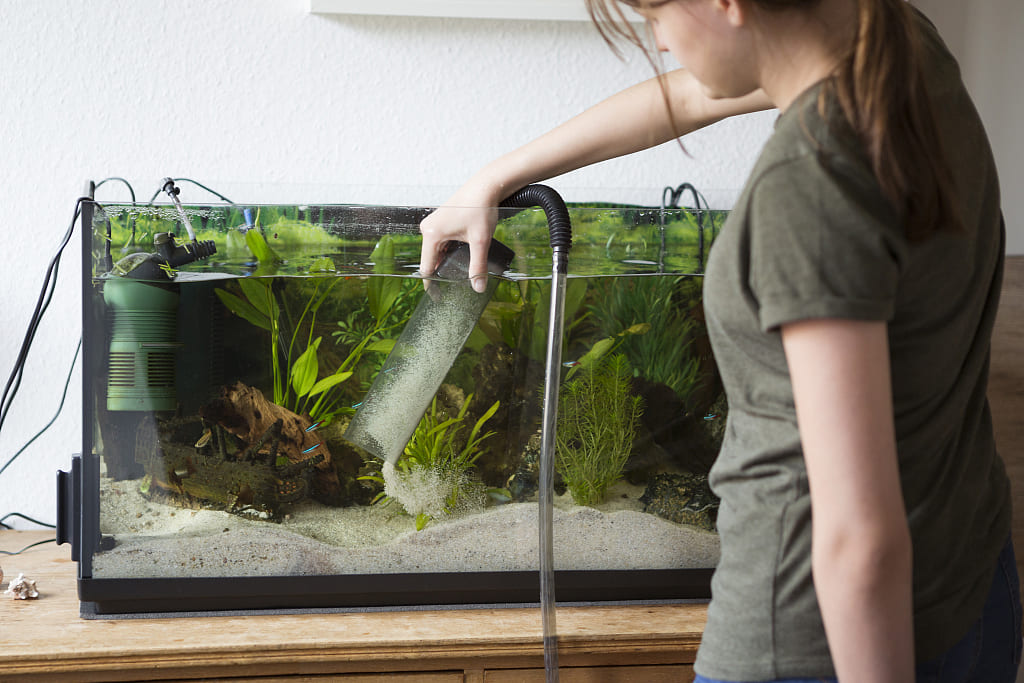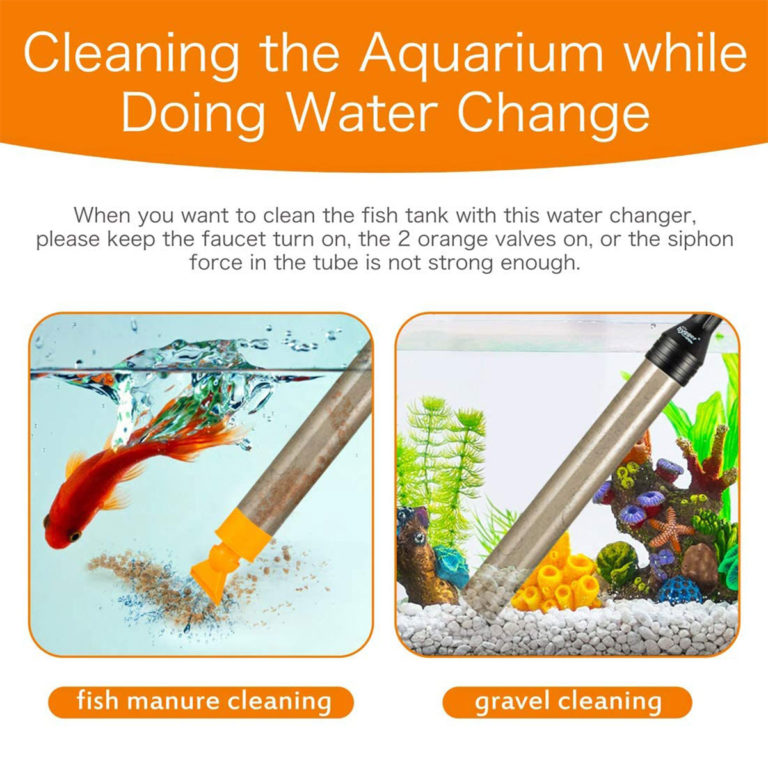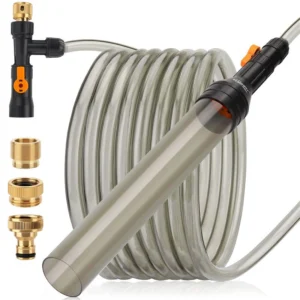If you have ever kept fish or played with a grass tank, you know that changing water is the most basic process to maintain stable water quality, healthy fish, and growing plants, and it is also a very important part. But many friends don’t pay attention to fish tank water changes or ignore some details when changing the water in or incorrect way, which leads to the fish and plants being deeply hurt.
Why do you need to change the water even though it looks like it’s very clear? Below I’ll talk to you about the importance of changing the aquarium water.
Why change aquarium clear water
Benefiting from technology, people can maintain an aquarium with only a little effort, although modern filtration is powerful, but also can not reach the powerful nature.
Nature can be said to be an extremely powerful filtering system. The normal decomposition is like this: a dead fish in a lake, is first eaten by other organisms as the first treatment, and then the rest is decomposed by bacteria.
The decomposition of bacteria is divided into aerobic bacteria and anaerobic bacteria. Aerobic bacteria including nitrite and nitrate bacteria, while anaerobic bacteria will finally break down nitrite and nitrate into ammonia, excluding the water surface to complete the overall decomposition process.
However, the aquarium contains a powerful filtration system, the last step still can not be done, because it is difficult to have an anaerobic zone. Anaerobic bacteria can not be formed, so reducing the nitrate in water is only complete by water changes, if not, over time the fish will be ammonia poisoning, resulting in death.
Sometimes we think the water is good or bad only from the turbidity, but this is not right. Many indicators of water quality cannot be seen with the naked eye, such as nitrate content, PH value, soft hardness, and so on, so many situations need to be solved. And I generally analyze the water from the fish state.
As I said before alkaline water raises fish like alkaline water, and vice versa, then clear water we will say that there is also a problem with the quality.
So the correct way to change water is to change the water partly every week, one-third or one-quarter according to the specific situation, and do not change the whole tank water at once to avoid fish discomfort.
What are the benefits of changing fish tank water?
First, improve water quality. This is the inevitable result of water change. The food residue and feces in the fish tank can release a lot of ammonia gas. It is the fish’s nemesis. If there is too much ammonia in the tank, it will lead to the collapse of the nitrifying bacterial system and the fish will die.
Therefore, regular water changes can ensure the reproduction of nitrifying bacteria and can effectively suppress ammonia.
Second, stimulate fish growth. When they encounter new water will also show abnormal excitement, to achieve the stimulating effect on growth. On the contrary, a static environment is no longer new to the ornamental fish. Mental numbness and growth will be slow.

What issues need to be noted when changing the water
1. Water volume
In addition to regular water change according to the actual situation, fish tank water change should also pay attention to the amount, generally speaking, only one-third to one-fifth is appropriate, if the landscape and plants and fishless, you can change to one-half; usually, the whole tank water change is not recommended, for it only happens when the fish is sick.
A small amount of water change can reduce the damage of chlorine, especially when your water is not through aeration or activated carbon, you should be more cautious.
2. Change speed
It should be slow, so that when you find the fish have discomfort, you can immediately stop the water change, and concentrate on observing the behavior of the fish when the symptoms of nervousness, shortness of breath, etc., immediately deal with, such as changing the tank or adding a large amount of water stabilization has been remedied.
3. Temperature change
When changing water, the temperature difference between the new water and the old water should not exceed ± 37°F, especially not to cause a sharp change in the difference. If the water temperature difference after the water change exceeds ± 37°F, fishes will appear uncomfortable phenomenon, the chances of fish disease will be greatly increased, and more than ± 41°F, fishes will be significantly uncomfortable, will be stimulated, and cause disease.
4. The frequency of water change
Fish water needs to be replaced regularly, not just randomly. This regular water change is not mechanical, but according to the season’s change and the state of the fish in a planned manner. Such as in the summer the temperature is high, water quality is easy to deteriorate, algae is easy to breed, it is easy to deplete the oxygen, and the frequency of water changes should be increased.
In winter, water quality is not so easy to become worse, algae metabolism is slowed down, and the frequency can be relatively reduced.
It is recommended to change the water twice a week in summer, and once a week or once every 10 days in winter.
For reference only, the frequency of water change should be determined according to the actual situation, such as if you have more fish, and more plants, but the filtration equipment is not very good, or even no, then you have to increase the frequency of water change, on the contrary, the frequency can be slow.
In general, if the stocking density in the fish tank is high, the power of the equipment in the fish tank is low, in this case, the water quality environment of the fish tank is more prone to pollution changes, so the frequency of water changes should be appropriate compact some, generally 5-7 days to replace 1 time.
If the stocking density is sparse and the equipment is working well, then the water change can be done once in 10-40 days.
5. PH value
You should know that in addition to the huge change in water temperature will bring harm to fish, the PH value of the huge change is also not small damage to the fish. When keeping a certain kind of fish, you have to clear this kind of fish’s survival of water temperature and PH value, water hardness, etc. First, adjust the water into a suitable environment for fish survival, and then change the water.
After typhoons, the rainy season, and other unfavorable water purification factors occur, avoiding changing water is the right decision.
Because, waterworks may add a larger amount of chlorine than usual to disinfect, for example, during the time of SARS, the chlorine in the tap water is increased four times.
In winter, what problems should one pay attention to when changing tank water?
In many cases, we can’t ensure the water change in winter in the fish tank and the newly added water, their temperature difference should not be so big. Here is the main fear of the temperature difference causing problems.
For example, the original fish tank is put on the heating rod, and it is kept the tropical fish, then the water temperature should be maintained in the range of 75-80 degrees. At this time we change the water by most of the tap water, tap water temperature is certainly not so high, after all, winter external plumbing is cold.
Unless you are ready to change the water, you can also use a heating rod to heat it to the same water temperature, it is straightforward to change.
If it is not, the tap water may only be 10 degrees, which impacts the fish, likely to be too much difference in water temperature, resulting in tropical fish getting white spot disease.
In winter it is recommended that we change the water less. Unless you can warm up the water you are going to change, then you can change the water as before. If you can not, it is recommended to feed less, and then only adding evaporated water is good. Our strategy can also be appropriate to change every half of a month or once a month. After all, our feeding quantity is also reduced accordingly.
However, the frequency of water change for fish tanks in winter can be reduced in general, and keep the temperature difference between the two as small as possible. When you change the water, try not to impact the fish, you can use your hand to block, or pour the water against other places that can buffer.
Ways to change the water in the aquarium
Water change can be done in the following 3 ways:
1. General water change
Drain 1/10-1/5 of the tank water every day, then inject the same amount of new water along the tank wall.
2. Medium water change
After keeping fish for some time, there will be a layer of yellowish-brown algae on the tank wall, the thicker the brown algae is, the more it affects the beauty. At this time, change more than 1/4-1/2 of the tank water at once. Unless there are special circumstances, the time interval between water changes is at least one month.
To reduce the frequency of water changes, you can get a magnetic fish tank cleaner to clean the inside of the fish tank regularly.
3. Complete water changes
Often it is due to serious water quality failure, or moss overgrowth that leads to overturning the tank: fish out, settle down, brush away the moss and other dirt on the original tank wall, rinse the filter cotton thoroughly, re-inject the new water with equal temperature, leave it for a few moments to wait for the temperature to be equal, and then fish into the original tank.
Steps to change aquarium water
Here is one of the best ways to help to change fish tank water more conveniently – Hygger Aquarium Water Change.
This Water Changer can be used to clean and change the water in small to medium-sized tanks. The tank siphon pump which works on pressure, allows the aquarium water to be drained while the aquarium is being cleaned. It makes cleaning and changing water much faster. Another great feature is the convenient outlet, which clips into a drain bucket. The hose is long and easy to use.
You can clean your gravel easily with the gravel cleaning attachment. This tool pulls dirt and debris out of your gravel, leaving only the pebbles. It is simple to use and has an easy-to-use one-way manual pump. It works by allowing you to make 10 quick squeezes and helps you remove the grit and waste from the bottom of the tank. Using the hose is also very convenient.

Hygger Aquarium Water Changer can be connected to a faucet or a hose. It works with most fish tanks and aquariums. The changer has three hose connectors that will fit most faucets. There are three sealing rings to ensure that you don’t lose the connection. Once connected, the water changer can change tank water quickly and effectively. This is especially helpful.
There are 4 steps how to change fish tank water:
1: Connect the flexible hose to the water flow assembly and the gravel tube.
2: Submerge the gravel tube in the aquarium tank and keep its orange valve closed.
3: Keep the water flow assembly orange valve open, and open the faucet.
4: Open the gravel tube valve, then the dirty water will be sucked into the hose and flow away.
Tips to Use the Aquarium Water Changer
1. If the faucet has a sprayer or filter head, you need to unscrew that and then screw the connector onto the faucet.
2. When you drain the water from the tank, the water flow assembly valve should be open. Please close the vacuum tube valve first.
3. The sinks you are using should be level with the tank or lower than it. To turn on or off the orange control valves, you just need to rotate the valve by 1/4 turn up or down.
In any case, changing the water is an important lesson that any fish keeper has to be careful of. In my house, the bathtub is not used for bathing, but for standby, it will be the second aquarium when a real crisis happens one day.



Leave a comment